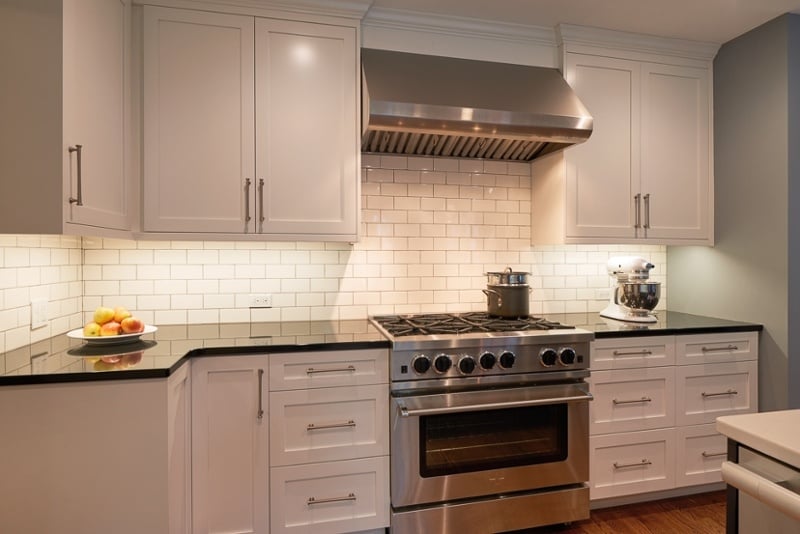
What’s the first thing you see when you enter a kitchen? The cabinets. They encompass over 50% of the kitchen’s visual space, making them the most dominant design element in the room. Kitchen cabinets do more than just store your essentials—they define the overall style, support an efficient workflow, and can even improve your Seattle home’s resale value.
Cabinets are the focal point in your kitchen space, and their choice will:
- Set the mood of the kitchen
- Add décor
- Affect the layout
- Affect workflow efficiency
- Determine storage capacity
- Determine kitchen lifespan
Among all the kitchen cabinet styles, shaker-style cabinets remain a design favorite for their timeless aesthetic and versatility. This kitchen cabinet style works beautifully in a variety of design styles, from traditional to transition, contemporary to modern. If you’re considering a kitchen remodel and want cabinets that balance practically and look, our guide to shaker kitchen cabinets will help you make the most informed decision!
Everything You Need to Know About Shaker Style Cabinets
What are Shaker Style Cabinets?
Originally crafted by the Shaker religious community in the 18th century, these cabinets were designed for durability and practicality—the same qualities that make them popular today! This style is characterized by clean lines, square edges and a recessed center panel. Shaker-style kitchen cabinet doors are best known for having a center indent. The center panel is flat and the edges are square with no other ornamentation. This simple, classic look gives them the ability to complement a wide range of kitchen designs.
Why Choose Shaker Cabinets?
There are many reasons a shaker-style cabinet is a popular choice for kitchen cabinets, such as:
- Timeless aesthetic: the minimalistic design ensures they never go out of style
- Versatile design: they blend seamlessly with nearly any type of kitchen design including modern, rustic, or farmhouse
- Boost resale value: Seattle homebuyers love a classic, clean look!
- Highly customizable: from finishes to hardware, shaker cabinets offer tons of customization options to suit your style
Let’s dive further into your practical guide to shaker-style cabinets.
The Best Materials for Shaker Cabinets
The material you choose for your cabinets will impact their durability, cost, and overall look. Here are some of the most common materials for shaker-style cabinetry:
Traditional Hardwood
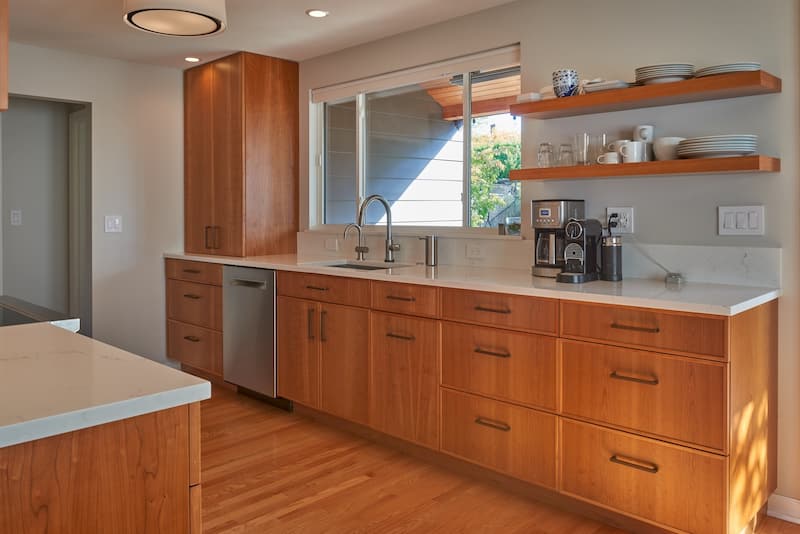
Traditional hardwood is a common option for shaker style kitchens. Hardwood is the gold standard for shaker cabinets thanks to its natural beauty, wide range of finishes and longevity. Different wood species, like oak, maple or cherry, make it even more customizable with their unique grain patterns that add warmth and texture to your kitchen.
Medium-Density Fiberboard (MDF)
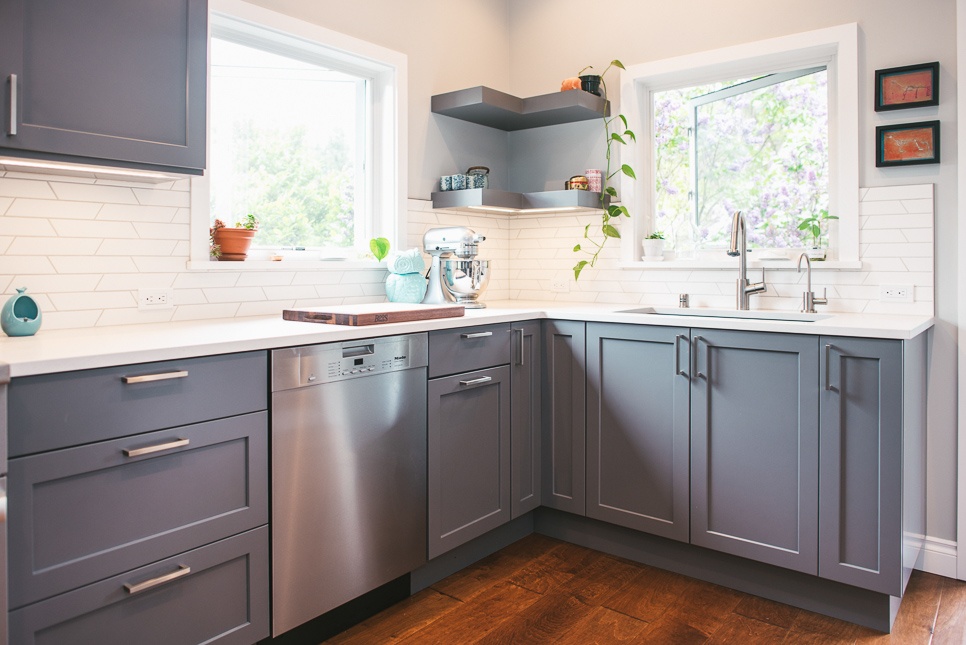
MDF is a popular alternative to solid wood, especially if you prefer the look of painted shaker cabinets. What makes MDF cabinets stand out is their ability to take paint better than other materials.
Nowadays, paint is a popular option, and most painted cabinets have MDF doors. High-quality MDF, characterized by a dense construction and durable adhesive, is among our most popular cabinet door materials. MDF has the added benefit of resisting warping and checking, something to which solid wood is prone.
Pro tip: If you’re opting for white shaker cabinets, we’ve found that MDF is a better choice than solid wood because it provides a smoother finish with no visible wood grain.
Plywood
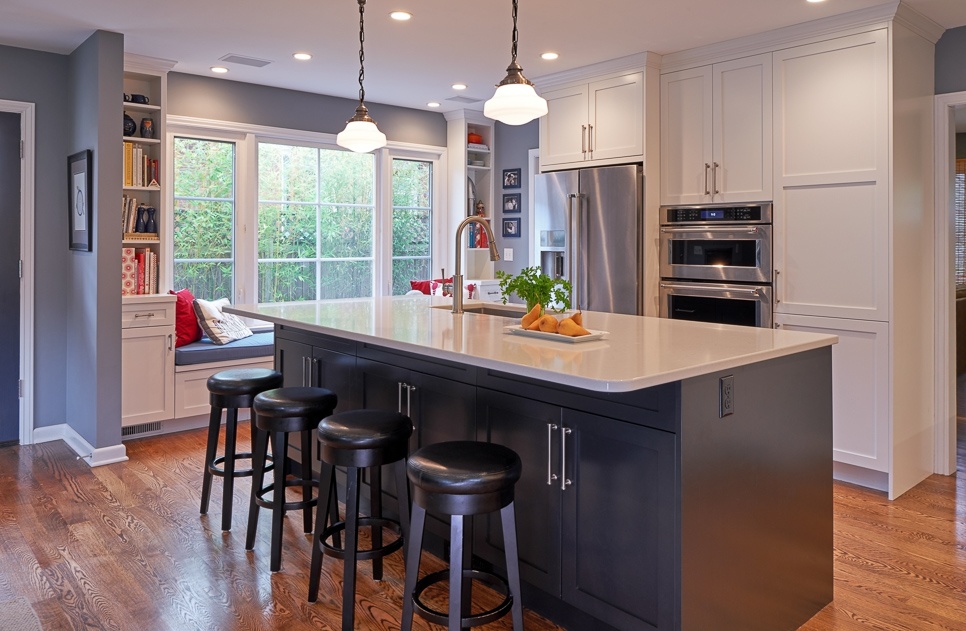
Another option to consider is plywood, which is known for its strength and stability. Plywood has three or more layers of veneers. Each layer is glued with grain at right angles to adjacent layers for strength.
Wood veneer is a thin slice of wood or bark. Typically, it’s thinner than ⅛ inch, and it’s glued onto core panels. Core panels can be wood, medium-density fiberboard, or particle board. Once glued, it produces flat panels for cabinets.
Plywood shaker cabinets are a great middle-ground option between hardwood and MDF because they provide much-needed longevity and affordability.
Choosing the Right Hardware for Shaker Cabinets
While shaker cabinets are known for their minimalistic look, the right hardware can enhance their style and add a special touch. Here are some of our favorite hardware options to consider::
- Ceramic knobs — A true classic. They will give your shaker kitchen the feel of an old-world farmhouse or a cozy cottage.
- Flat bar pulls — Sleek and modern. These are sharp and smooth and will go well with square edges in your kitchen. Install them to emphasize light and dark cabinets, quartz countertops, and geometric tiles
- Latches — Retro vibes. Choose latches for a nostalgic trip back in time. Be aware that they are not the most functional in a hurry. However, if you have pets or kids, they are a perfect choice, as they provide additional safety.
- Tubular Bar Pulls — Modern and sophisticated. They are paired best with darker finishes and bigger tiles. You can choose a shorter or longer version, and you can position them horizontally or vertically.
The Best Finishes for Shaker Cabinets
When it comes to shaker style, repetition is king. All the drawers and cabinets must look the same to get a clean and orderly look. Because shaker cabinets are highly customizable, the finish you choose will impact both their appearance and maintenance.
There are different finishing methods to shaker kitchen cabinets—here are a few to consider:
Painted Finishes
Painting the shaker cabinets is the perfect choice for a crisp, contemporary look. It allows you to maintain the sharp, recessed, squared-off edges. This option works well with MDF and solid wood—plus can be easily repainted for future updates.
See also: Painted Cabinets 101: How to Update Your Kitchen Without a Full Remodel
Thermofoil Finishing
Thermofoil is a vinyl wrap applied to cabinet doors.. Usually, it's found in secondary-use areas, like laundry rooms, rental properties or for budget-conscious remodels.
If you choose this option, you have to be careful about the areas where the panel meets the rail and where the stile is located on the cabinet.The thermofoil doesn’t produce as sharp an edge as painting. Also, the machine used for laminating can’t reach the corners and it will angle on the edges of the rail and stile. Because it isn’t as durable, it can peel over time.
Polyurethane Finishing
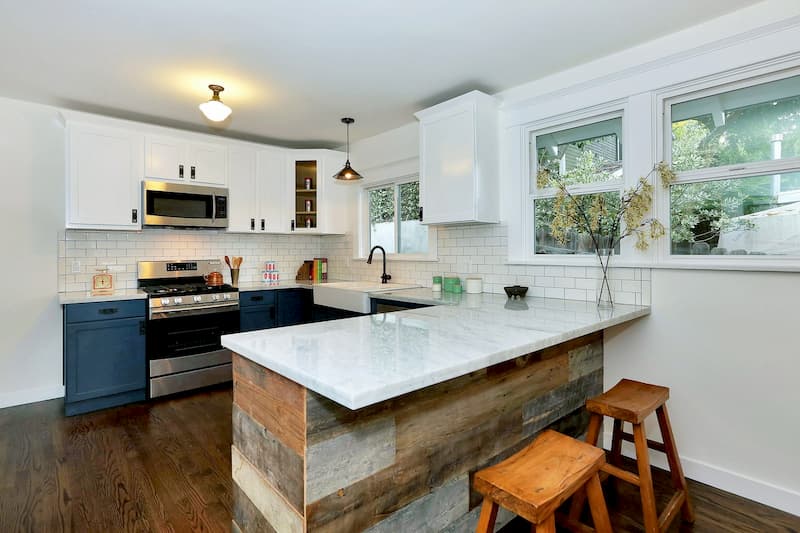
If you are going for a natural look, choose polyurethane because you can choose the level of sheen, including a matte finish, which enhances the grain and streaks while also providing durability.
Want more? Here are more kitchens to get you inspired.
See also: The Ultimate Guide to Kitchen Remodeling
Shaker Cabinet Construction: Face Frame vs Frameless
You’re probably wondering how shaker kitchen cabinet doors are made?
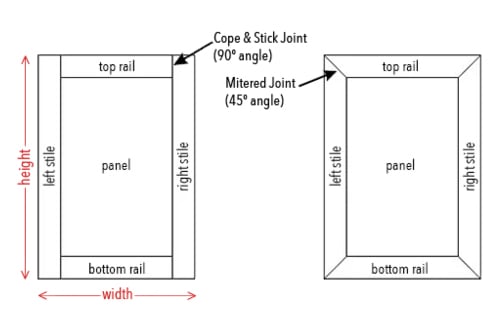
Screenshot from: fcustomcabinetsupply.com
First, it helps to know that shaker doors are a five-piece construction:
- 2 stiles
- 2 rails
- A flat panel
A stile is a piece of wood vertically positioned in the cabinet frame.
There are two cabinetry kitchen designs to get acquainted with before you embark on your kitchen remodel: face frame and frameless. These two styles have more to do with the cabinet box than the doors, but they do affect the look of your shaker cabinets, and they are an important consideration when making your design choices.
Face Frame Shaker Kitchen Cabinets
In the face frame method, the cabinet door is fitted in an outer wooden frame.
This method is characterized by longevity and durability, achieved by excellent craftsmanship, and a more traditional look.
The pros of face frame shaker cabinets include:
- Long-lasting — Face Frame cabinet construction is more labor-intensive. However, compared to the lay-on method, the finish is a higher quality.
- Finishing touches — These cabinets are fitted with butt hinges. Each hinge is chopped in manually to make sure the fit is perfect. Hinges made this way, have a strong bond that doesn’t weaken with time.
- Finishing options — It comes down to your preference. You can go for solid wood or MDF. The appearance is more traditional compared to lay-on cabinets.
Frameless Shaker Kitchen Cabinets
Frameless shaker kitchen doors, also known as full-overlay cabinets, lack a front frame because the doors lay on top of the cabinet box for a sleek and modern look.
Advantages of this option include:
- Affordability — This style is less labor-intensive. This means for less money you still get the shaker look you want
- Modern finish — Your new kitchen will have those clean shaker lines and a singular appearance.
- Additional storage space — Because of the way these cabinets are constructed, the cabinet openings are slightly larger. This means more storage to play with.
See also: Face Frame Cabinets Are Back
Frameless Shaker Kitchen Cabinets
Shaker-style cabinets bring a timeless versatility and improved durability to any kitchen remodel. Whether your design aesthetic is modern, farmhouse or transitional, this style of cabinets provides the perfect foundation for a well-designed kitchen.
Looking for expert help to bring your dream kitchen to life? CRD Design Build specializes in custom cabinetry solutions tailored to your needs. Contact us today to start planning your kitchen remodel!
Guide to Hiring a Remodeler
This comprehensive guide walks you through all the steps of choosing who will design and build your project, vetting remodeling companies, and ensuring that you have the best experience.






